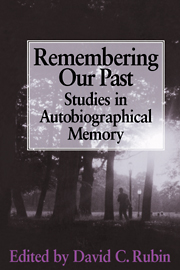Book contents
- Frontmatter
- Contents
- List of contributors
- 1 Introduction
- Part I Approaches
- Part II Accuracy
- 5 Time in autobiographical memory
- 6 The pliability of autobiographical memory: Misinformation and the false memory problem
- 7 Autobiographical memory in court
- Part III Emotions
- Part IV Social functions
- Part V Development and disruption
- Subject index
- Author index
6 - The pliability of autobiographical memory: Misinformation and the false memory problem
Published online by Cambridge University Press: 14 October 2009
- Frontmatter
- Contents
- List of contributors
- 1 Introduction
- Part I Approaches
- Part II Accuracy
- 5 Time in autobiographical memory
- 6 The pliability of autobiographical memory: Misinformation and the false memory problem
- 7 Autobiographical memory in court
- Part III Emotions
- Part IV Social functions
- Part V Development and disruption
- Subject index
- Author index
Summary
One aspect of autobiographical memory that has received considerable attention during the past two decades deals with the psychological mechanisms that underlie the memory and report of eyewitnesses. The misinformation effect is particularly concerned with what happens to people when they witness an event, such as a crime or accident, and are later misinformed about some aspect of the original event (Loftus, 1992). As is well known, eyewitnesses are not secluded after witnessing an event. Rather, they may discuss the event with other witnesses, and they are usually extensively questioned by criminal justice personnel both before and during any criminal or civil court appearance (Loftus, 1975, 1979). Such interactions provide ripe opportunities for the introduction of misinformation.
Recent experimental work supports the view that misinformation affects memory, and therefore, that actual eyewitnesses may be susceptible to making unintentional false reports. In fact, false reports have been relatively easy to induce in the laboratory. After exposure to misinformation, subjects have been induced to report having seen a variety of nonexistent objects, such as yield signs (Loftus, Miller, & Burns, 1978), hammers (McCloskey & Zaragoza, 1985a), eggs (Ceci, Ross, & Toglia, 1987), mustaches (Gibling & Davies, 1988), broken glass (Loftus & Palmer, 1974) and even something as large as a barn (Loftus, 1975). This research shows that misinformation can be dangerously robust in compromising the accuracy of the memory and report of actual eyewitnesses.
- Type
- Chapter
- Information
- Remembering our PastStudies in Autobiographical Memory, pp. 157 - 179Publisher: Cambridge University PressPrint publication year: 1996
- 25
- Cited by



